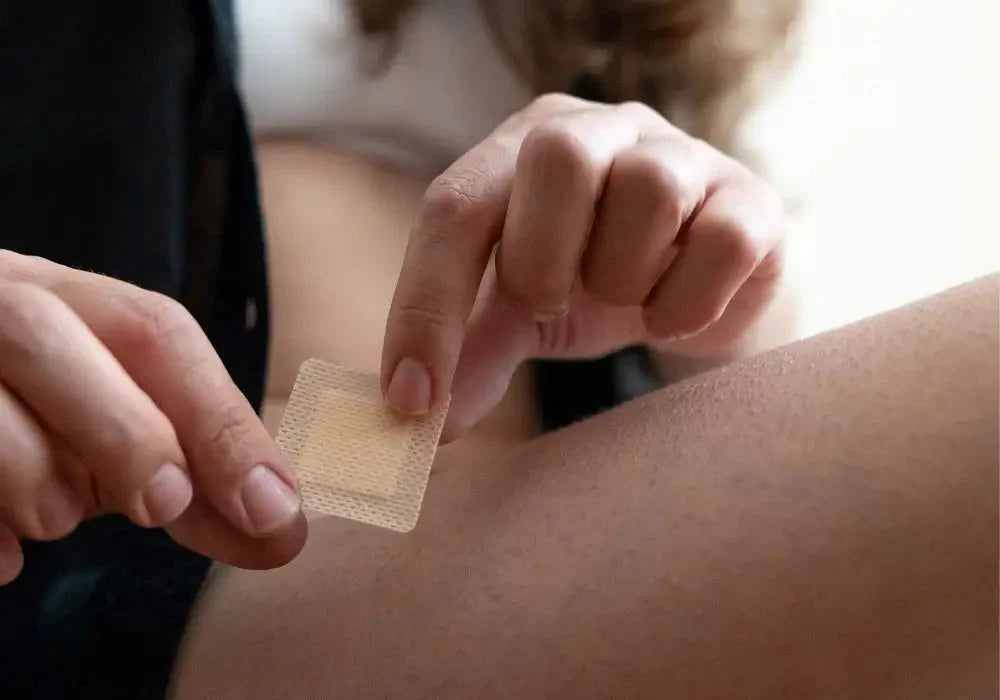
Navigating HRT – Everything you need to know
Navigating HRT – Everything you need to know
By Dr Rachel Hines
Hormone replacement therapy (HRT) plays a vital role in managing menopause symptoms for many people, but it’s not for everyone. Some rave that it changed their life, others try it for six months but don’t get on with it. Some people never need or just don’t want it.
Whether you're actively seeking help for your symptoms or just want to learn more about menopause, understanding how HRT works and who it can help is key. Here, we explore its benefits, when to consider it and treatment alternatives if it’s not for you.
What is HRT?
As the name suggests, hormone replacement therapy (HRT) is a kind of medication that supplies your body with hormones that are produced at lower levels during menopause.
It has been consistently proven to be the most effective treatment for a range of menopause symptoms such as mood changes, hot flushes, painful sex and bladder symptoms.
What are the different types of HRT?
There are three different hormones you may need during menopause and two main types. Each hormone can also be taken in different ways, such as transdermally (through the skin) through a patch, cream or gel, or orally, as a tablet. Your doctor will help you decide which hormones and products are right for you. Here’s a summary of some of the options you may discuss.
Oestrogen
Menopause symptoms are mainly caused by fluctuating and declining oestrogen levels. Supplying your body with this hormone helps improve many menopause symptoms, which may include hot flashes, mood swings, vaginal dryness or trouble sleeping.
Read more about the 34 symptoms of menopause.Progesterone
Progesterone is prescribed alongside oestrogen if you still have your womb. When used alone, oestrogen can cause the lining of the womb to thicken, which increases the risk of developing womb cancer Thankfully, using progesterone alongside oestrogen removes this risk. Taking oestrogen and progesterone together is called combined HRT.
Testosterone
Testosterone is relatively new to the HRT scene. It is currently only prescribed for people who are stable on their systemic HRT (oestrogen with or without progesterone) and are still experiencing low libido.
Read more about testosterone HRT.Systemic HRT
This is HRT that is absorbed into the bloodstream and has effects across your body. This means it is used to treat body-wide - also known as systemic - menopause symptoms. Oestrogen, progesterone and testosterone can all be taken systemically.
Vaginal oestrogen
Vaginal HRT is applied inside your vagina - or to the wider genital area - and only works in the area where it is applied. It is a great option for people with vaginal, vulval or urinary symptoms, and can be used either alone or alongside systemic HRT. Vaginal HRT is always oestrogen only.
Unlike other forms of oestrogen, you do not need to use progesterone if you’re taking vaginal oestrogen alone.
There are quite a few more complexities to explore, but that covers the basics!
When should you start HRT?
There is no single answer to this question - we are all very different. Ultimately, it is your choice, and your doctor can help you make an informed decision once they are sure that menopause is behind your symptoms. Questions to consider together include:
- Are you open to hormonal treatment?
- Is HRT a safe option for you?
- How are your menopause symptoms impacting your life?
And what does science say? It's best to start HRT within ten years of menopause and before the age of 60 to gain maximum cardiovascular benefits, according to research. Cardiovascular health relates to the health of the heart and blood vessels.
Your doctor will usually advise you to start HRT straight away if you are diagnosed with premature ovarian insufficiency.
Read more about when to start HRT.
What are the risks and benefits of HRT?
These will be different for everyone, as we all have a unique menopause experience and individual risk factors linked to our personal or family medical histories. The risks and benefits are also unique to the type of HRT you take.
Benefits of HRT
Menopause symptom relief is the main benefit of HRT. It is the most effective treatment for many menopause symptoms, including:
- Night sweats
- Hot flushes
- Mood changes, including low mood
- Sleep issues
- Genitourinary syndrome of menopause - this is an umbrella term for vaginal and urinary symptoms such as vaginal dryness, painful sex and frequent urination
There are some other benefits too. HRT may also help:
- Protect the health of your bones, according to research
- Protect your heart and blood vessels- research suggests this happens if you start HRT within 10 years of menopause or before the age of 60
-
Reduce your risk of bowel cancer, as emerging evidence
suggests
Risks of HRT
As with any medication, there are also risks to consider. These risks do not apply to all types of HRT and will be more or less important depending on your medical history.
- Increased risk of breast cancer. Oestrogen-only HRT - including vaginal HRT - causes little or no change to your risk of breast cancer. Combined HRT (oestrogen and progesterone) may increase your risk - about as much as drinking two or more units of alcohol per day, and not as much as being overweight.
- Increased risk of blood clots with oral HRT (tablets)
- Increased risk of stroke with oral HRT (tablets), more so when started in women over the age of 60
It is worth reading more about the benefits and risks of HRT to help inform your decision. There is still a lot for scientists to discover, but we know more now than ever before.
Who can take HRT?
You will be prescribed HRT if the benefits outweigh the risks for you personally. Due to the risks outlined above, doctors will not generally prescribe systemic HRT if you have any of the following:
- Breast cancer, whether past, present or suspected
- Known or suspected oestrogen-dependent cancers (meaning those which grow in response to oestrogen, most often in the breast, ovary, womb or endometrium)
- Certain types of arterial disease such as angina or heart attack
- Unexplained vaginal bleeding
- Untreated endometrial hyperplasia (abnormal thickening of the lining of the womb)
- Certain types of venous thromboembolism (blood clots) including pulmonary embolism (PE) and deep vein thrombosis (DVT), unless you are already on medications to thin the blood (anticoagulants)
- Thrombophilic disorders (conditions which increase your blood’s tendency to clot)
- Liver disease with abnormal blood tests
- Pregnancy
Systemic HRT can sometimes be used for women with the above risk factors under specialist guidance. You may also still be able to take vaginal HRT even if you are not eligible for systemic treatment.
There are a few other conditions and risk factors that may influence your doctor when prescribing HRT. Fortunately, there are other ways to treat and manage your menopause symptoms if HRT is not a safe recommendation for you.
What can you do if you can't take HRT?
Both non-hormonal medications and lifestyle changes can help manage common symptoms. Many people combine these approaches - sometimes it takes a bit of trial and error to find your most effective solution.
Hot flushes
Non-hormonal medications that can help hot flushes and other menopausal symptoms include:
- SSRI antidepressants, such as sertraline, citalopram or fluoxetine
- Clonidine
- Gabapentin
- Fezolinetant (Veozah) - a new medication now available in the UK on private prescription.
Bladder and vaginal issues
Vaginal oestrogen is the most effective treatment for the genitourinary syndrome of menopause (GSM), which includes symptoms like increased urinary frequency, vaginal dryness and painful sex. Itis generally safe to use, even if combined HRT is too risky for you.
Non-hormonal options include:
- Vaginal moisturisers. These are widely available to help vaginal dryness or painful sex
- Lubricants. Try a pH-balanced lubricant to relieve painful sex
Other symptoms
Many lifestyle changes can have a huge impact on your menopause symptoms, including hot flashes, sleep issues, anxiety, bladder and vaginla symptoms and low mood. Try to:
- Get enough exercise
- Maintain a healthy weight
- Eat a nutritious diet
- Consider decreasing your caffeine, alcohol and/or nicotine intake
Summary
HRT may not be suitable for you because of your medical history or you may just prefer not to take it. That’s ok, HRT isn’t for everyone - there are alternative, non-hormonal medications and lifestyle change can make a real difference too. Your doctor will help you make an informed decision.
If you would like to find out what your treatment options are, we have partnered with online menopause clinic, Stella, to give you access to their tailored menopause care. With Stella, you can skip NHS waiting times and talk to a doctor who has additional training in women’s health within a week. They will explain your options and if HRT is suitable, then send it to you in the post. You also get access to the Stella menopause app, where you can follow self-guided lifestyle change plans, speak to a real-life coach and try menopause-friendly workouts and recipes. All this for just £135. Take Stella’s assesment today.
About the author
Dr Rachel is a GP and expert in menopause health. She has completed advanced menopause training with the Faculty of Sexual and Reproductive Healthcare and is on the British Menopause Society specialist register. She also has diplomas in sexual and reproductive healthcare, gynaecology and child health, and has specialised in women’s health throughout her career.



